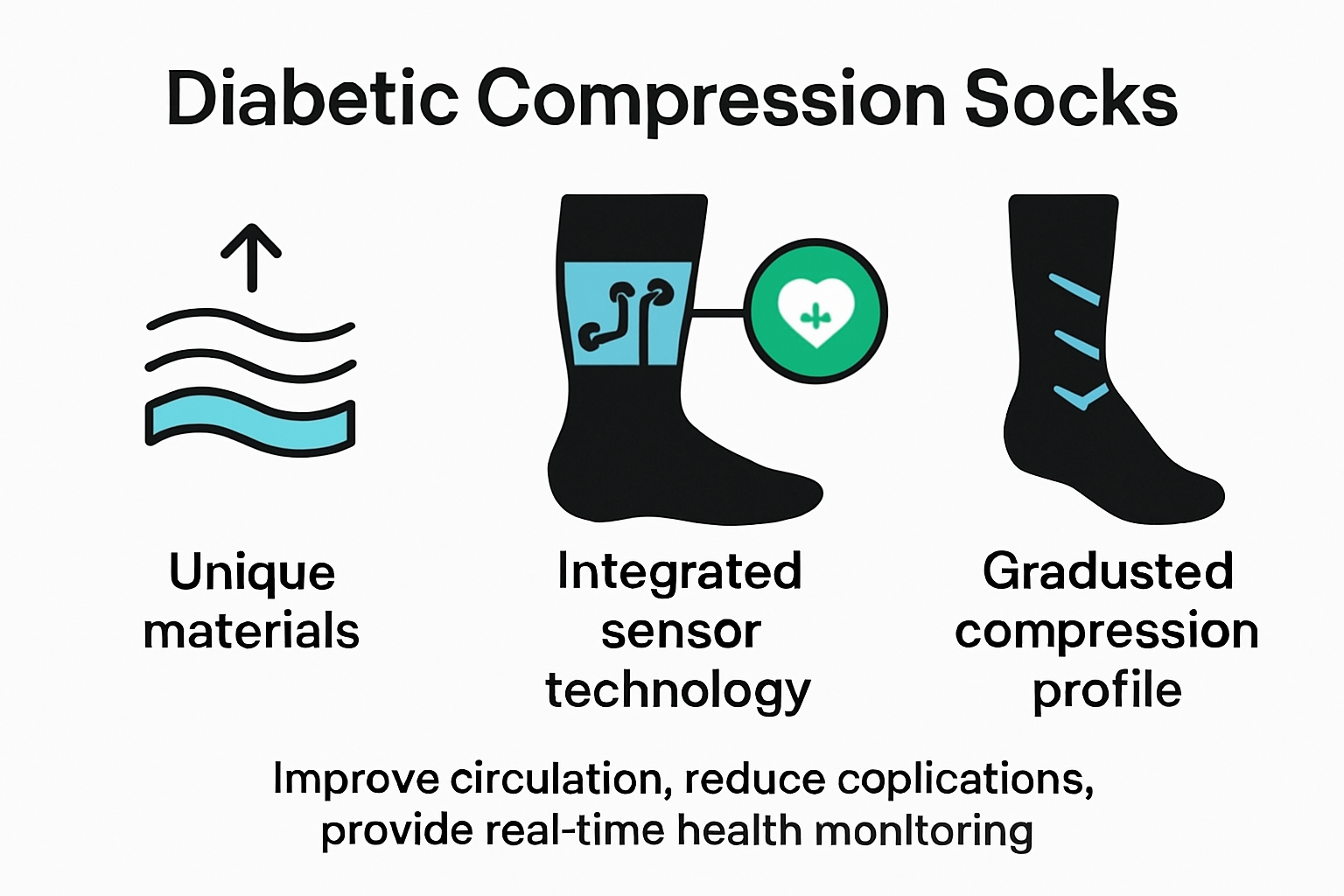
Diabetic Compression Socks: Benefits, Uses, and How to Choose (2025)
Share

Diabetic compression socks do more than just look different from regular socks. Some modern pairs now feature built-in sensors that monitor foot temperature, pressure, and even blood oxygen levels in real time. Expecting a basic medical sock? Think again. These smart socks are quietly transforming how people with diabetes and other circulatory problems protect their health with every single step.
Table of Contents
- What Makes Diabetic Compression Socks Unique
- Key Benefits For Different Health Needs
- How To Choose And Wear Diabetic Compression Socks
- Care Tips And Common Questions For Users
Quick Summary
| Takeaway | Explanation |
|---|---|
| Diabetic compression socks offer unique benefits. | These socks provide specialized support for diabetes-related foot issues, enhancing protection and comfort. |
| Smart technology enhances health monitoring. | Integrated sensors track foot temperature and pressure, aiding early detection of potential complications. |
| Proper sizing is crucial for effectiveness. | Accurate measurements ensure the right level of compression for optimal circulation and comfort. |
| Material selection impacts skin health. | Choose moisture-wicking, breathable fabrics to prevent infections and improve overall foot health. |
| Regular maintenance extends sock life. | Follow washing and care guidelines, and replace socks every 3-6 months to ensure compression remains effective. |
What Makes Diabetic Compression Socks Unique
Diabetic compression socks represent a specialized medical garment designed to address the unique health challenges faced by individuals with diabetes. Unlike standard socks, these therapeutic garments offer comprehensive protection and support for diabetic patients’ sensitive foot and leg conditions.
Advanced Material and Design Considerations
The fundamental difference between diabetic compression socks and regular socks lies in their sophisticated engineering. Learn more about specialized diabetic foot protection reveals that these socks are constructed with unique materials and features specifically tailored to diabetic patients’ needs. According to research from the National Institutes of Health, diabetic socks are crafted with several critical characteristics:
-
Moisture Management: Advanced moisture-wicking fabrics prevent excess sweating, reducing the risk of fungal infections and bacterial growth. This is crucial for diabetic patients who often experience reduced sensation in their feet.
-
Seamless Construction: Traditional socks with multiple seams can create friction points that lead to blisters or skin irritations. Diabetic compression socks feature minimal or no seams, dramatically reducing potential skin damage risks.
-
Padding and Protection: Strategic cushioning in high-pressure areas provides additional protection against foot ulcers and helps distribute walking pressure more evenly.
Intelligent Sensor Technology
Recent technological advancements have transformed diabetic compression socks from simple protective garments into sophisticated health monitoring tools. A groundbreaking study published in Sensors Journal highlighted an innovative smart compression sock integrated with temperature, plantar pressure, and blood oxygen sensors. These advanced socks can detect significant variations in biomarkers associated with potential foot complications, offering real-time health monitoring for diabetic patients.
The sensors embedded within these socks can track critical metrics such as:
- Foot temperature variations
- Pressure distribution while walking
- Blood oxygen levels in the lower extremities
This technological integration represents a significant leap forward in proactive diabetes management, enabling early detection of potential health risks before they become serious complications.
Circulation and Compression Dynamics
Unlike standard compression garments, diabetic compression socks provide a carefully calibrated level of pressure designed to support blood circulation without restricting blood flow. Clinical research from the American Diabetes Association emphasizes the importance of graduated compression that promotes venous return while preventing fluid accumulation.
The unique compression profile in these specialized socks helps:
- Reduce swelling in lower extremities
- Minimize the risk of blood clots
- Support overall cardiovascular health for diabetic patients
By combining advanced materials, intelligent sensor technology, and precise compression mechanics, diabetic compression socks offer far more than traditional foot coverage. They represent a critical health management tool designed to protect, monitor, and support individuals managing diabetes-related circulatory challenges.

Key Benefits for Different Health Needs
Diabetic compression socks offer targeted health benefits beyond standard footwear, addressing complex medical conditions and supporting individuals with diverse physiological challenges. Their specialized design provides comprehensive therapeutic advantages for multiple health scenarios.
Diabetes-Related Circulatory Management
For individuals managing diabetes, compression socks play a critical role in preventing serious lower extremity complications. Explore our detailed diabetic foot care guide reveals the intricate ways these specialized garments support vascular health.
According to research published in the Journal of Diabetes Research, mild compression therapy demonstrates remarkable benefits for diabetic patients. A pilot study showed statistically significant improvements in key health metrics:
- Reduced Circumference: Participants experienced notable decreases in calf and foot circumferences
- Improved Skin Hydration: Cutaneous water content was effectively managed
- Zero Adverse Events: No skin lesions or vascular complications were observed during controlled testing
The graduated compression mechanism promotes enhanced blood circulation, mitigating risks associated with peripheral neuropathy and potential wound development. By maintaining consistent, gentle pressure, these socks help prevent blood pooling and reduce inflammation in vulnerable lower extremity regions.
Lymphatic and Edema Management
Beyond diabetic care, compression socks provide substantial benefits for individuals struggling with lymphatic disorders and chronic swelling. Clinical research from the National Lymphedema Network indicates that strategic compression can significantly improve fluid dynamics and reduce chronic edema.
Specialized compression socks support lymphatic function through:
- Encouraging lymph fluid movement against gravity
- Reducing tissue swelling in lower legs and ankles
- Preventing fluid accumulation and associated discomfort
- Supporting muscle recovery after prolonged standing or physical activity
Patients with conditions like lymphedema, venous insufficiency, and post-surgical recovery find these socks instrumental in managing their symptoms and improving overall mobility.
Pregnancy and Athletic Recovery Support
Pregnant women and athletes represent two distinct populations that significantly benefit from compression sock technology. A comprehensive medical study demonstrated that mild compression (18-25 mmHg) effectively reduces lower extremity edema without compromising vascular integrity.
For pregnant women, compression socks offer critical advantages:
- Minimizing leg and ankle swelling
- Reducing the risk of deep vein thrombosis
- Alleviating leg fatigue and discomfort
Athletes similarly leverage compression socks for:
- Enhanced muscle recovery
- Reduced muscle vibration during performance
- Improved blood circulation during and after intense physical activities
These targeted benefits highlight how diabetic compression socks transcend traditional medical garments. By addressing specific physiological needs with precision engineering, they provide a versatile solution for managing complex health challenges across diverse patient populations.
How to Choose and Wear Diabetic Compression Socks
Selecting and wearing diabetic compression socks requires careful consideration to ensure maximum therapeutic benefit and comfort. Learn more about expert compression sock recommendations can help individuals navigate the critical factors in making the right choice.
Compression Level and Sizing Considerations
Determining the appropriate compression level is fundamental to achieving optimal health benefits. According to research published in the International Journal of Lower Extremity Wounds, diabetic patients should focus on mild to moderate compression levels, typically ranging from 15-30 mmHg.
Key sizing and compression guidelines include:
- Professional Measurement: Get precise measurements from a healthcare professional
- Graduated Compression: Choose socks with graduated pressure that’s strongest at the ankle and decreases toward the calf
-
Compression Range:
- 15-20 mmHg: Mild compression for daily wear and prevention
- 20-30 mmHg: Moderate compression for active management of circulatory issues
Important sizing factors to consider:
- Accurate ankle and calf circumference measurements
- Proper foot length measurement
- Accounting for any swelling or volume changes throughout the day
Material Selection and Skin Protection
The Joslin Diabetes Center emphasizes the critical importance of material selection for diabetic compression socks. Ideal materials should provide moisture management, breathability, and minimal skin irritation.
Recommended material characteristics:
- Moisture-Wicking Fabrics: Prevent excess sweating and bacterial growth
- Seamless Construction: Reduce friction and potential skin damage
- Breathable Fibers: Maintain optimal skin temperature and humidity
- Antimicrobial Properties: Additional protection against infections
Special considerations for individuals with sensitive skin or neuropathy include:
- Selecting hypoallergenic materials
- Avoiding rough or abrasive fabrics
- Choosing socks with soft, non-binding elastic
Proper Wearing and Maintenance Techniques
Correct application and care of diabetic compression socks are as crucial as their initial selection. Healthcare professionals recommend a systematic approach to wearing and maintaining these specialized garments.
Essential wearing guidelines:
- Morning Application: Put on socks before significant swelling occurs
- Smooth Application: Ensure no wrinkles or bunching that could create pressure points
- Daily Inspection: Check feet and socks for any signs of irritation or damage
- Rotation: Have multiple pairs to allow proper washing and drying between uses
Maintenance recommendations:
- Wash in mild detergent
- Air dry or use low heat
- Replace socks every 3-6 months or when elasticity diminishes
- Avoid fabric softeners that can break down elastic properties
While diabetic compression socks offer significant health benefits, individual needs vary. Consulting with a healthcare provider ensures personalized guidance tailored to specific medical conditions, foot anatomy, and circulatory health. Regular follow-ups and professional assessments help optimize the therapeutic potential of these specialized medical garments.
Care Tips and Common Questions for Users
Navigating the world of diabetic compression socks requires understanding proper care, maintenance, and addressing common user concerns. Explore our comprehensive care guide to ensure you maximize the longevity and effectiveness of these specialized medical garments.
Proper Cleaning and Maintenance Techniques
According to research from Very Well Health, maintaining diabetic compression socks involves specific care protocols to preserve their therapeutic properties. Proper cleaning is not just about hygiene but also about maintaining the sock’s structural integrity and compression capabilities.
Essential cleaning recommendations include:
-
Washing Instructions:
- Use mild detergent specifically designed for delicate fabrics
- Wash in a mesh laundry bag to prevent stretching
- Use cold or lukewarm water
- Avoid fabric softeners that can break down elastic fibers
-
Drying Techniques:
- Air dry when possible
- If using a dryer, select low heat settings
- Avoid direct sunlight or high heat that can damage elastic
-
Fabric Care:
- Use a sweater comb to remove fabric pills
- Inspect for signs of wear like thinning, holes, or reduced elasticity
- Replace socks every 3-6 months or when compression properties diminish
To help users keep track of the cleaning and replacement routine, here’s a checklist-style table summarizing key maintenance steps for diabetic compression socks:
Keep track of essential sock maintenance tasks with this checklist to ensure your diabetic compression socks stay effective and comfortable:
| Maintenance Task | Recommended Frequency | Completed? |
|---|---|---|
| Wash socks with mild detergent | After each use | |
| Use mesh laundry bag for washing | Every wash | |
| Air dry or use low-heat dryer setting | Every dry | |
| Inspect for thinning/holes | Weekly | |
| Replace socks | Every 3-6 months or as needed | |
| Avoid fabric softeners | Every wash |
Application and Wear Best Practices
Trualta’s comprehensive guide highlights critical steps for correctly putting on and wearing diabetic compression socks to maximize their therapeutic benefits and prevent potential complications.
Key application guidelines:
-
Pre-Application Skin Check:
- Examine feet and legs for redness, chafing, or pressure sores
- Ensure skin is clean and completely dry
- Apply moisturizer if needed, but allow it to absorb fully
-
Proper Wearing Technique:
- Sit or lie down during application
- Turn sock inside out up to the heel
- Slide foot into sock carefully
- Gradually roll sock up, smoothing out wrinkles
- Ensure sock sits smoothly without bunching
-
Daily Wear Considerations:
- Put on socks in the morning before significant swelling occurs
- Remove and inspect feet daily
- Rotate between multiple pairs to allow proper rest and washing
To make the wearing process easier to follow, here’s a step-by-step process table summarizing the proper technique for putting on diabetic compression socks:
Follow this step-by-step guide for safely and comfortably applying your diabetic compression socks:
| Step | Action | Details |
|---|---|---|
| 1 | Inspect feet and legs | Check for redness, sores, and clean/dry skin |
| 2 | Position yourself | Sit or lie down |
| 3 | Prepare sock | Turn sock inside out up to the heel |
| 4 | Position foot | Carefully slide foot into sock |
| 5 | Apply sock | Gradually roll sock up the leg, smoothing wrinkles |
| 6 | Check fit | Ensure sock sits smoothly without bunching |
| 7 | Inspect after application | Check for pressure points or irritation |
Addressing Common User Questions
Wikipedia’s medical compression guidelines provide insights into the most frequently asked questions about diabetic compression socks. Understanding these details helps users make informed decisions and use their socks effectively.
Frequently Asked Questions:
-
How Long Should I Wear Compression Socks?
- Typically recommended for daytime use
- Follow healthcare provider’s specific guidance
- Remove during sleep unless otherwise directed
-
Can I Wear Compression Socks with Other Footwear?
- Choose shoes with adequate room
- Avoid tight shoes that might compress socks
- Ensure socks remain smooth and undistorted
-
What Signs Indicate I Need to Replace My Socks?
- Visible thinning of fabric
- Loss of elasticity
- Persistent wrinkles or inability to stay smooth
- Visible holes or wear patterns
While diabetic compression socks offer significant health benefits, individual experiences can vary. Always consult with a healthcare professional for personalized advice tailored to your specific medical condition and needs. Regular monitoring and professional guidance ensure you receive the maximum therapeutic potential from your compression socks.

Frequently Asked Questions
What are diabetic compression socks?
Diabetic compression socks are specialized garments designed to support circulatory health for individuals with diabetes. They often feature moisture-wicking materials, seamless construction, and graduated compression to manage foot discomfort and prevent complications.
How do diabetic compression socks help with diabetes management?
These socks improve blood circulation, reduce swelling, and prevent conditions like neuropathy and foot ulcers. The graduated compression promotes venous return, maintaining healthy blood flow in the legs and feet.
Are there any smart features in modern diabetic compression socks?
Yes, many modern diabetic compression socks come with intelligent sensor technology that monitors foot temperature, pressure, and blood oxygen levels in real-time, aiding in proactive health management.
How do I properly choose and wear diabetic compression socks?
To choose the right diabetic compression socks, consider factors like compression level (typically 15-30 mmHg), proper sizing, and material selection. Wear them in the morning before swelling begins, and ensure they fit smoothly without wrinkles to maximize their effectiveness.
Take the Next Step in Diabetic Foot Health—Shop Expert Solutions
If you are worried about circulation, swelling, or foot discomfort from diabetes, you are not alone. The article highlighted how the right compression socks—especially those with advanced features like moisture-wicking fabrics, seamless construction, and optimal compression levels—are key to protecting sensitive diabetic feet. At Fit Stockings, we understand the daily challenges of managing your health and offer products that meet these high standards. Explore our selection of leading medical brands, including Jobst diabetic compression socks, designed specifically for your needs and recommended by healthcare professionals.
Stop waiting for pain or complications before taking action. Visit Fit Stockings now to discover our full range of diabetic compression socks and find the size, style, and medical grade to keep you comfortable and protected. Shop today so you can stay in control of your foot health with proven therapeutic solutions. If you want our latest product recommendations and tips, start at our home collection and take the next step to healthier, safer feet.
Recommended
- Compression Stockings and Diabetes: What to Know in 2025 – Fit Stockings
- How to Choose Compression Socks: A Helpful Guide for 2025 – Fit Stockings
- Compression Stockings Fitting Guide 2025: Find the Perfect Fit – Fit Stockings
- The Ultimate Guide to Compression Stockings: Comfort, Health, and Styl – Fit Stockings

